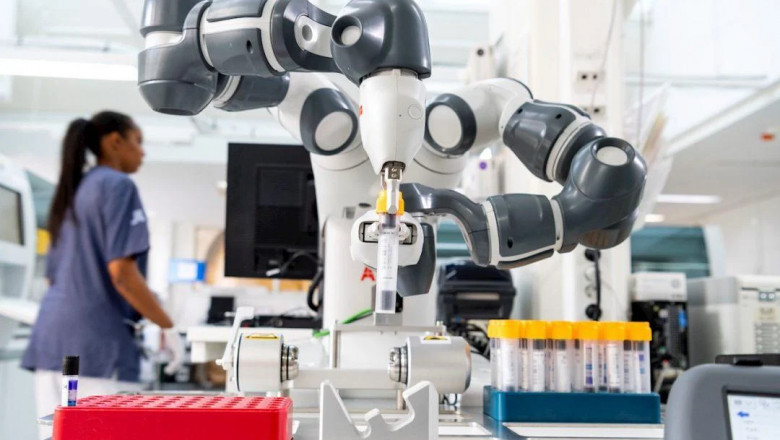views
Collaborative robots, or cobots, have emerged as one of the most transformative innovations in modern automation. Unlike traditional industrial robots, which are designed to work in isolation within safety cages or confined spaces, collaborative robots are built to work alongside humans in a shared environment. They bring significant benefits to businesses by enhancing productivity, improving safety, and enabling new kinds of collaborative workflows. The collaborative robots market has seen a surge in demand across industries such as manufacturing, logistics, and healthcare, and this trend is expected to continue as advancements in technology make cobots more affordable, efficient, and easier to deploy.
Key Market Drivers
Several factors have driven the growth of the collaborative robots market. One key factor is the increasing demand for automation solutions across industries. Traditional robots often require substantial investments in safety infrastructure and are not as flexible as cobots. As the need for cost-effective and adaptable automation systems grows, businesses have recognized the value of integrating cobots into their operations.
Cobots also offer significant advantages over their traditional counterparts in terms of cost. They are typically smaller, easier to install, and less expensive to maintain, making them an attractive option for small and medium-sized enterprises (SMEs) looking to automate processes. The ease of use of cobots is another important factor; they are designed with intuitive user interfaces and can be reprogrammed quickly to carry out a variety of tasks, from assembly and packaging to quality inspection and collaborative assembly.
Another key driver is the shortage of skilled labor in many industries. The integration of cobots helps businesses address the challenges of labor scarcity by allowing human workers to focus on higher-value tasks while the robots handle repetitive, physically demanding, or hazardous activities. By working together, cobots and human employees can create a more efficient and flexible work environment.
Key Market Restraints
Despite their promise, the collaborative robots market does face a few challenges. One of the most significant constraints is the initial cost of deployment, which might still be prohibitively high for some businesses. While cobots are typically more affordable than traditional industrial robots, there are still upfront costs for purchasing the robotic units, setting up the necessary infrastructure, and training employees to work with the technology.
There is also the challenge of integration with existing systems. Many businesses have legacy equipment and processes that need to be adapted to work seamlessly with cobots. This can require customization, additional investments, or an entirely new system design to ensure smooth and effective implementation.
Another limitation comes from concerns regarding cybersecurity. As cobots rely heavily on sensors, data transmission, and connectivity, businesses must be vigilant about the security of their robotic systems to prevent potential cyberattacks. Ensuring that the robots communicate safely and securely with the overall industrial network is paramount in maintaining operational continuity.
Regional Insights
The collaborative robots market is witnessing significant growth across various regions. North America has historically been one of the largest markets for automation technologies, driven by the industrial and automotive sectors' early adoption. However, Asia-Pacific is expected to experience the fastest growth, driven by advancements in manufacturing in China, Japan, and South Korea. These countries are increasingly investing in robotics technology to improve manufacturing efficiency and handle the challenges of labor shortages and rising operational costs.
Europe is also witnessing a surge in collaborative robots adoption, particularly in the automotive, electronics, and consumer goods sectors. European countries like Germany, France, and the UK are key contributors to the adoption and integration of robotics within industry 4.0 frameworks.
Industry Applications
The collaborative robots market is growing across multiple industries, where the demand for labor optimization and advanced automation solutions is particularly high. The manufacturing sector, including industries like automotive, electronics, and consumer products, has embraced cobots for assembly, material handling, and quality control tasks. Logistics is another area where cobots are making a big impact; robots are being used in warehouses for packaging, sorting, and even assisting workers with heavy lifting.
Healthcare is also emerging as a promising sector for cobots, with robots performing tasks like drug dispensing, surgery assistance, and even patient care. The possibilities are expanding as collaborative robots become more integrated into healthcare facilities, offering great potential to enhance patient outcomes and optimize workflows.
Competitive Landscape
The collaborative robots market is highly competitive, with several major players constantly evolving their offerings to stay ahead. Companies such as Universal Robots, FANUC, ABB, KUKA, and Yaskawa Electric Corporation dominate the market. These companies are continually focusing on advancements in robotics hardware, software, and safety protocols to develop more efficient, user-friendly robots. Additionally, many of them have adopted strategic partnerships and acquisitions to improve their market share.
Future Outlook
Looking ahead, the collaborative robots market is poised for substantial growth as industries worldwide continue to embrace automation. Increasing demand for efficiency, cost reductions, and the need for flexible, collaborative workflows will accelerate the adoption of cobots in new sectors. The continuous improvement of artificial intelligence, machine learning, and Internet of Things (IoT) technologies will make collaborative robots even smarter, more versatile, and more capable of performing complex tasks in a broader range of industries. As businesses begin to see the immense value that cobots can provide, their adoption is expected to expand in the coming years, ushering in a new era of automation.






















Comments
0 comment